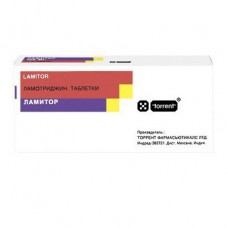Expiration date: 01/2025
Composition
Tablets. One tablet contains 25, 50 or 100 mg lamotrigine
pharmachologic effect
Anticonvulsant (antiepileptic) drug. Voltage-gated sodium channel blocker. Pulsed discharge unit causes neurons in culture and inhibits the excessive release of glutamate (amino acids that play a key role in the generation of epileptic seizures), along with the glutamate-induced inhibition of effector pulses.
Pharmacokinetics
Suction
After oral lamotrigine is rapidly and completely absorbed from the gastrointestinal tract. Cmax in plasma observed after 2.5 ± 1.5 hours after oral administration. Time to reach Cmax somewhat lengthened in the case of taking the medication after a meal, but the extent of absorption remains unchanged. The pharmacokinetics is linear up to a dose of 450 mg - the maximum single dose, which has been investigated. There is considerable individual variation Cmax value of the drug, but the individual concentrations vary very little.
Distribution
Plasma protein binding is approximately 55%.
Metabolism
It is metabolized in the liver to form predominantly glucuronide.
breeding
T1 / 2 in healthy adults is 24-35 hours.
Averages clearance in healthy people is 39 ± 14 ml / min.
Lamotrigine excreted in the urine as glucuronides. Less than 10% is excreted unchanged in the urine. Only 2% of the products of metabolism excreted in the feces.
Pharmacokinetics in special clinical situations
T1 / 2 Lamotrigine is largely dependent on the concomitant medication.
T1 / 2 Lamotrigine reduced to 14 hours when combined with the drugs that induce the activity of cytochrome P450 isoenzymes such as carbamazepine and phenytoin, and increases in the average to about 70 hours in the case of combined use of sodium valproate.
T1 / 2 of lamotrigine in children is usually shorter than in adults. T1 / 2 for children is approximately 7 hours while taking medicine inducing activity of isoenzymes, such as carbamazepine, phenytoin, phenobarbital, and primidone. T1 / 2 is increased to 45-55 hours when combined with the admission of sodium valproate.
Studying the pharmacokinetics of single doses of lamotrigine in patients with kidney disease suggest that the pharmacokinetic parameters vary slightly, but the concentration of the main metabolite glucuronide increases almost 8 times due to lower renal clearance.
testimony
Lamitor recommended as monotherapy and adjunctive therapy for adults and children over 12 years:
- simple partial seizures;
- complex partial seizures;
- secondarily generalized tonic-clonic seizures;
- primary generalized tonic-clonic seizures;
- typical absence seizures;
- atypical absence seizures;
- myoclonic seizures;
- seizures refractory to other antiepileptic drugs of any kind.
- Lamitor also used as adjuvant therapy for children aged 2 to 12 years.
Contraindications
expressed human liver;
Hypersensitivity to lamotrigine or other components of the preparation.
Application for violations of liver function
Contraindications hepatic dysfunction.
Application for violations of renal function
In patients with impaired renal function in the terminal stage of the disease can be expected accumulation of metabolites in the form of glucuronide. Therefore, if necessary, the appointment to such patients should be careful.
Use in children
The initial dose Lamitor for children from 2 to 12 years, not taking sodium valproate but taking other antiepileptic drugs that induce isozymes is 2 mg / kg / day (2 doses) during the first 2 weeks and 5 mg / kg / day ( in 2 hours) in the next 2 weeks. The maintenance dose - 5-15 mg / kg / day (2 admission).
The initial dose for children Lamitor taking sodium valproate in combination with other antiepileptic drugs that induce isozymes, is 0.2 mg / kg, 1 time / day for the first 2 weeks, followed by 0.5 mg / kg, 1 time / day for the next 2 weeks. Thereafter, the dosage should be increased until the optimum therapeutic effect. Maintenance dose - 1.5 mg / kg (in 1 or 2 divided doses).
Pregnancy and breast-feeding
The drug should not be administered during pregnancy and lactation, except when the expected benefit of therapy to the mother outweighs the potential risk to the fetus and child.
special instructions
Information on the use of Lamitor in elderly patients is limited. Therefore, caution should be prescribed to these patients.
In excess doses Lamitor may develop skin rash (drug in this situation should be abolished).
In some cases, the appointment of the drug may develop severe skin rash (including Stevens-Johnson syndrome). Such reactions are more likely to develop in children. Lamitor must be canceled at the first sign of the onset of rash. The risk of these complications increases as the appointment Lamitor simultaneously with sodium valproate and if used Lamitor dose exceeds the recommended initial and the maximum daily dose.
With the development of skin rash use of the drug should be discontinued immediately.
When using Lamitor possible development of hypersensitivity symptoms (in some cases up to the development of death), fever, malaise, cold symptoms, drowsiness, lymphadenopathy, facial edema, and in rare cases - liver function abnormalities, disorders of blood (leukopenia and thrombocytopenia) . In most patients, these symptoms disappear after canceling Lamitor.
If you have any rash during treatment with the drug, fever, cold symptoms, sleepiness, deterioration of control seizures (especially during the first month) should monitor liver function tests, renal function, blood clotting.
With a sharp lifting Lamitor perhaps more frequent seizures. Lamitor dose should be reduced gradually over 2 weeks.
In patients with impaired renal function in the terminal stage of the disease can be expected accumulation of metabolites in the form of glucuronide. Therefore, if necessary, the appointment to such patients should be careful.
Effects on ability to drive vehicles and management mechanisms
The possibility to drive vehicles and operate moving mechanisms while taking Lamitor decided individually, taking into account the clinical situation.
Dosing and Administration
Lamitor initial dose for adults and children over 12 years, not taking sodium valproate but taking other antiepileptic drugs that induce isozymes is 50 mg 1 time / day. for the first 2 weeks and 100 mg / day. (2 administration) during the next 2 weeks. Then, the dose should be increased to 200-400 mg / day. (2 admission).
Lamitor starting dose for patients receiving valproate sodium in combination with other antiepileptic drugs that induce isozymes is 25 mg every other day for the first 2 weeks and then one 25 mg once / day. for the next two weeks. Thereafter, the dosage should be increased until the optimum therapeutic effect. The maintenance dose - 100-200 mg (1 or 2 admission).
Initial dose Lamitor children 2 to 12 years, receiving sodium valproate but taking other antiepileptic drugs that induce isozymes is 2 mg / kg / day (two doses) for the first 2 weeks and 5 mg / kg / day. (2 administration) during the next 2 weeks. The maintenance dose - 5-15 mg / kg / day (2 admission)..
The initial dose for children Lamitor taking sodium valproate in combination with other antiepileptic drugs that induce isozymes, is 0.2 mg / kg, 1 time / day. for the first 2 weeks, followed by 0.5 mg / kg 1 time / day. for the next two weeks. Thereafter, the dosage should be increased until the optimum therapeutic effect. Maintenance dose - 1.5 mg / kg (in 1 or 2 divided doses).
Side effects
Side effects have been reported with the appointment Lamitor as monotherapy
CNS: dizziness, headache, drowsiness, sleep disturbances, fatigue.
From the digestive system: nausea.
Allergic reactions: maculo-papular rash (2%), most often noted in the first 4 weeks after the beginning of treatment and disappear after discontinuation of the drug. In some cases, - Stevens-Johnson syndrome, angioedema, toxic epidermal necrolysis.
Side effects reported with Lamitor appointment as an adjunct therapy to standard antiepileptic drugs
CNS: dizziness, headache, drowsiness, impaired balance, fatigue, irritability, aggressiveness, tremor, confusion.
On the part of the organ of vision: diplopia, disturbance of the visual acuity.
From hemopoiesis system: neutropenia, leukopenia.
From the digestive system: nausea, vomiting, diarrhea phenomenon.
Drug interactions
While the use of antiepileptic drugs that induce liver isoenzymes (phenytoin, carbamazepine, phenobarbital, primidone), enhanced metabolism Lamitor that may require an increase in the dose.
Sodium valproate, lamotrigine with competing against metabolizing isoenzymes the liver, inhibits its metabolism. There is no evidence that Lamitor able to induce or inhibit hepatic isoenzymes metabolizing other drugs. Lamitor can induce its own metabolism but the effect is very minimal and does not cause serious clinical manifestations.
Although some patients experience changes in the concentrations of other anti-epileptic drugs in plasma, conducted controlled studies have not confirmed the impact on the levels of both Lamitor received antiepileptic drugs in blood plasma. These studies, carried out in vitro, suggest that Lamitor does not compete with other antiepileptic drugs for binding sites to plasma proteins.
Overdose
Symptoms: nystagmus, ataxia, dizziness, drowsiness, headache, nausea, unconsciousness, coma.
Treatment: gastric lavage, activated charcoal. If necessary spend symptomatic therapy.
Storage conditions
The drug should be stored in a dark and dry place at a temperature no higher than 30 ° C.
Shelf life
2 years.







